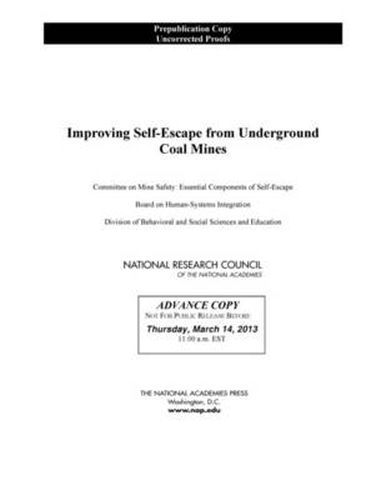Readings Newsletter
Become a Readings Member to make your shopping experience even easier.
Sign in or sign up for free!
You’re not far away from qualifying for FREE standard shipping within Australia
You’ve qualified for FREE standard shipping within Australia
The cart is loading…






Coal mine disasters in the United States are relatively rare events; many of the roughly 50,000 miners underground will never have to evacuate a mine in an emergency during their careers. However, for those that do, the consequences have the potential to be devastating. U.S. mine safety practices have received increased attention in recent years because of the highly publicized coal mine disasters in 2006 and 2010. Investigations have centered on understanding both how to prevent or mitigate emergencies and what capabilities are needed by miners to self-escape to a place of safety successfully. This report focuses on the latter - the preparations for self-escape.
In the wake of 2006 disasters, the U.S. Congress passed the Mine Improvement
and New Emergency Response Act of 2006 (MINER Act), which was designed to strengthen existing mine safety regulations and set forth new measures aimed at improving accident preparedness and emergency response in underground coal mines. Since that time, the efforts of the National Institute of Occupational Safety and Health (NIOSH) and the Mine Safety and Health Administration (MSHA) have contributed to safety improvements in the mining industry. However, the Upper Big Branch mine explosion in 2010 served as a reminder to remain ever vigilant on improving the prevention of mine disasters and preparations to help miners survive in the event of emergencies.
This study was set in the context of human-systems integration (HSI), a systems approach that examines the interaction of people, tasks, and equipment and technology in the pursuit of a goal. It recognizes this interaction occurs within, and is influenced by, the broader environmental context. A key premise of human-systems integration is that much important information is lost when the various tasks within a system are considered individually or in isolation rather than in interaction with the whole system. Improving Self-Escape from Underground Coal Mines, the task of self-escape is part of the mine safety system.
$9.00 standard shipping within Australia
FREE standard shipping within Australia for orders over $100.00
Express & International shipping calculated at checkout
Coal mine disasters in the United States are relatively rare events; many of the roughly 50,000 miners underground will never have to evacuate a mine in an emergency during their careers. However, for those that do, the consequences have the potential to be devastating. U.S. mine safety practices have received increased attention in recent years because of the highly publicized coal mine disasters in 2006 and 2010. Investigations have centered on understanding both how to prevent or mitigate emergencies and what capabilities are needed by miners to self-escape to a place of safety successfully. This report focuses on the latter - the preparations for self-escape.
In the wake of 2006 disasters, the U.S. Congress passed the Mine Improvement
and New Emergency Response Act of 2006 (MINER Act), which was designed to strengthen existing mine safety regulations and set forth new measures aimed at improving accident preparedness and emergency response in underground coal mines. Since that time, the efforts of the National Institute of Occupational Safety and Health (NIOSH) and the Mine Safety and Health Administration (MSHA) have contributed to safety improvements in the mining industry. However, the Upper Big Branch mine explosion in 2010 served as a reminder to remain ever vigilant on improving the prevention of mine disasters and preparations to help miners survive in the event of emergencies.
This study was set in the context of human-systems integration (HSI), a systems approach that examines the interaction of people, tasks, and equipment and technology in the pursuit of a goal. It recognizes this interaction occurs within, and is influenced by, the broader environmental context. A key premise of human-systems integration is that much important information is lost when the various tasks within a system are considered individually or in isolation rather than in interaction with the whole system. Improving Self-Escape from Underground Coal Mines, the task of self-escape is part of the mine safety system.